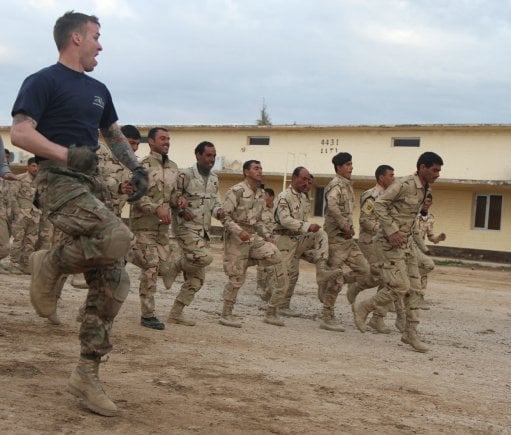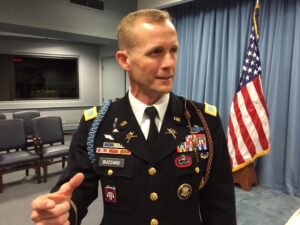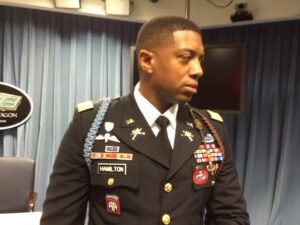
An 82nd Airborne soldier trains Iraqi troops.
PENTAGON: Newly created, US-trained units are leading the Iraqi Army counteroffensive against the Islamic State, officers of the 82nd Airborne Division said this morning. Yes, the recapture of Ramadi is moving slowly, acknowledged Col. Curtis Buzzard and Maj. Michael Hamilton, but at least it is moving, and the Iraqi troops they mentored are not only holding their ground but advancing.
Neither officer offered a comparison to Syria, but even limited success in Iraq makes a stark contrast to the collapse of US efforts to train a moderate Syrian opposition. For that matter, even limited success in Iraq today is a stark contrast to last year’s rout in which fleeing Iraqi forces ceded much of the country — and much US-provided equipment — to ISIL.
The Iraqis trained by Col. Buzzard’s 3rd Brigade, by contrast, were new recruits who joined the Iraqi Army after the Islamic State advance. These men are full of patriotic fervor — or at least Shia Arab hatred for the Sunni ISIL — and willing to fight.

Col. Curtis Buzzard
“The majority of units that we trained were new units,” Buzzard told reporters at the Pentagon. “These were new soldiers that had joined the army and were very nationalistic. I remember being at an Iraqi Army brigade one graduation and the whole brigade’s chanting, ‘We’re going to Mosul! We’re going to Mosul!'”
The Mosul offensive was put on hold after Ramadi fell. But the new units’ enthusiasm transferred. “The 16th Iraqi Army Division and the 76th Brigade as part of that, they started as a subcomponent of one axis” in the multi-pronged march on Ramadi, said Buzzard. “Now…they’re basically the main effort.”
“The 16th Division, it stood up from scratch; it was a new unit when we first came in country,” added Hamilton. The 82nd Airborne guided them from “rudimentary training” all the way through operations in Ramadi, he said, where “they were probably the most successful Iraqi army unit participating in that operation.”
The Airborne’s training mission started with five brand-new brigades, Col. Buzzard said, and initially he was worried what would happen when those units graduated. But the Iraqis took to the training so enthusiastically that the training center, run by both US and allied Western troops, now has a waiting list. Iraqi units assigned to imminent major operations get jumped to the head of the queue.

82nd Airborne soldiers train Iraqis to fire on the move
The program must be customized depending on how much prior training each Iraqi unit has and how much time it has before it must go back into battle.
“We had training programs…that started from very basic soldier skills –marksmanship, medical skills, and soldier tasks like how to move in a formation — and progressed all the way up to battalion-level collective training, where hundreds of soldiers in a battalion formation were doing these complex maneuvers,” Hamilton said. That included live-fire exercises in realistic depictions of the roadside-bomb-strewn defensive belts ISIL had built around Ramadi.
The Airborne also advised Iraqi units, like the 16th Division, that had moved on from training to actual operations — although the Americans stayed back at base. That’s a stark contrast to the last time Buzzard and Hamilton were in Iraq, during the intense US-led fighting of 2007. It also makes things much harder than the pre-2011 approach, in which US forces mentored Iraqis under fire, fighting side by side.

Maj. Michael Hamilton
“We can’t accompany them on the battlefield and that presents a challenge, both to our own situational awareness of how they execute the operations and our ability to assist them in executing the operations,” Hamilton said. “It takes a lot of patience to let them lead the way, [but] it’s ultimately their fight to win or lose.”
“They’ve recognized they’ve got to do this on their own,” said Buzzard. “That’s something that’s a little bit different.”
Connecticut lawmakers to grill Army, Lockheed about job cuts at Sikorsky helicopter unit
“The Connecticut delegation has questions about why, with that [FY24] appropriation in hand, this happened,” said Rep. Joe Courtney, D-Conn.


























